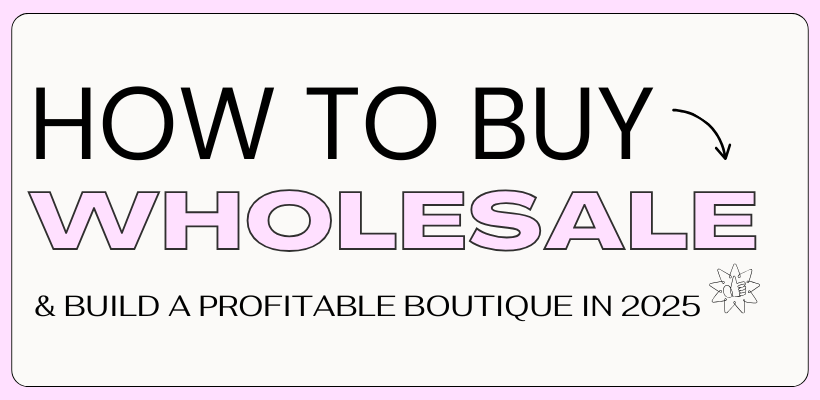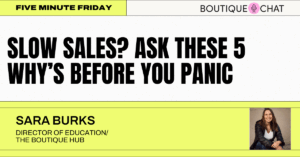Wholesale buying isn’t just about filling racks—it’s about making strategic, data-backed decisions that serve your customers, strengthen vendor relationships, and ultimately boost profitability. In our recent webinar, The Boutique Hub’s Director of Wholesale Samantha Conner tackled the most common challenges boutique owners face and outlined a smart, customer-first approach to buying that drives results. Here are the best takeaways!
1. Know Who You Are Buying For – Who Is Your Customer?
The smartest buying decisions begin with one essential question: Who are you buying for?
Before you hit “add to cart,” get clear on your ideal customer. Think beyond age and location—consider her lifestyle, daily habits, what she values, and how she shops. Is she chasing toddlers while running errands? A full-time professional who wants to look polished without the effort? Your customer avatar should guide every purchase you make, helping you choose pieces that solve problems and spark excitement.
2. Your Boutique’s Value Isn’t Just the Product
What makes your boutique special? It’s not just the clothes on the rack—it’s the experience you offer. From how you style pieces to your in-store atmosphere or online community, you’re selling more than fashion.
If you’re relying on “cute and affordable” as your pitch, it’s time to dig deeper. Value comes in many forms: convenience, styling services, exclusivity, or education. When you buy with that unique value in mind, you create a cohesive brand experience that sets you apart.
3. Choose the Right Vendors (And Don’t Settle)
Not all vendors are created equal. Look for those who offer more than just trendy products—they should also be reliable, communicative, and aligned with your store’s aesthetic and standards.
Before committing to large orders, start small and test new brands. Pay attention to quality, consistency, and customer feedback. Bonus points if they offer fast shipping, support small batches, or have flexible reordering options. Building a solid vendor list is a long-term strategy that pays off with time.
4. Budget by Category, Not Just by Month
It’s easy to overspend when you’re buying without a plan. Set a clear open-to-buy budget—and take it a step further by breaking that budget down by category. How much are you allotting for tops? Denim? Accessories? Set price point goals within each category to keep your assortment balanced.
This not only helps you stay on track financially, but it also ensures your inventory is curated and intentional rather than overstuffed and inconsistent.
5. Think Margin, Not Just Markup
Don’t get caught up in markup alone. What really matters is margin—how much money you’re actually keeping after a sale. Use tools like an ROI calculator to evaluate whether an item is worth the investment based on your average sell-through rate, return policies, and shipping costs.
Small shifts in buying decisions can create a big difference in overall profitability.
6. Marketing and Buying Should Work Together
Buying product is only half the battle—the other half is selling it. Before placing a new order, think ahead: how will you market it? What story does this collection tell? Does it align with upcoming holidays, themes, or promotions?
Plan your buys to support your content calendar and campaigns. When you coordinate delivery dates with social content and team training, you create a smoother and more successful sales flow.
7. Avoid These Buying Mistakes
Even experienced boutique owners fall into these common traps:
- Buying from the first vendor you find
- Ordering in bulk without testing styles first
- Shopping based on personal taste instead of customer data
- Forgetting to plan sell-through strategies
A good rule of thumb? If you can’t explain why you’re buying it and how you’ll sell it, skip it.
8. Explore Private Labeling for Higher Margins
Looking for exclusivity and better profits? Private labeling allows you to create your own branded product line—either by customizing existing vendor products or developing your own. You don’t need to go big at first; start with something simple like branded tags or exclusive prints.
It’s a great way to stand out, build brand loyalty, and gain more control over pricing.
9. Consider Nearshoring as a Buying Strategy
With rising shipping costs and longer lead times, more boutiques are exploring nearshoring—buying from vendors based in Mexico or South America. The proximity often means quicker turnaround, more flexible order minimums, and easier communication.
It’s a strategy worth exploring, especially if you want to diversify your vendor list or reduce overseas delays.
10. Use Inventory Exchanges to Reduce Risk
Buying smart also means having a backup plan. If a style doesn’t move, don’t let it collect dust—consider using a boutique-to-boutique inventory exchange group to sell or swap pieces with other retailers. It’s a great way to recoup costs, try new brands, and avoid markdown overload.
The Bottom Line: Buy With Purpose
Smart buying is less about gut feelings and more about strategy. When you know your customer, stick to a plan, and stay flexible in your sourcing, you create a boutique that feels curated, profitable, and uniquely you.
Looking for a Better Way to Buy?
That’s where Hubventory comes in. It’s the wholesale platform built by boutique owners, for boutique owners. With tools to track your budget, build vision boards, and shop from trusted, curated brands, Hubventory makes it easy to stay organized and buy with purpose.
✅ Shop by margin
✅ Build seasonal boards
✅ Discover exclusive deals
✅ Track your open-to-buy in real time
Ready to make smarter buying decisions? Start shopping on Hubventory today and take control of your inventory like never before.
- Why the LA Experience Is the Most Important Boutique Event of the Year
 by shannongordonThe Boutique Hub is heading to the PGA Buying Summit in Frisco, TX for the first time, tapping into the fast-growing golf apparel market projected to hit $13B by 2032. Golf fashion is evolving beyond the course, creating big opportunities for boutique retailers. The Hub team will be connecting with brands, discovering new trends, and offering live education and retail audits at the event on July 28th. Boutique owners interested in athleisure, activewear, or preppy styles should consider adding golf-inspired looks to their lineup. VIP perks available through The Hub’s exclusive registration link.
by shannongordonThe Boutique Hub is heading to the PGA Buying Summit in Frisco, TX for the first time, tapping into the fast-growing golf apparel market projected to hit $13B by 2032. Golf fashion is evolving beyond the course, creating big opportunities for boutique retailers. The Hub team will be connecting with brands, discovering new trends, and offering live education and retail audits at the event on July 28th. Boutique owners interested in athleisure, activewear, or preppy styles should consider adding golf-inspired looks to their lineup. VIP perks available through The Hub’s exclusive registration link. - Meet Ask Ashley: Your Boutique Business Bestie is Here!
 by shannongordonBack to school season is the second busiest shopping season of the year! How are you going to capitalize this year? This time of year is going to be here before we know it, so its time to get busy prepping! Back to school time is a perfect opportunity to host an event or run a sale to attract new customers for the busy shopping season. Lets get into our top back to school marketing ideas!
by shannongordonBack to school season is the second busiest shopping season of the year! How are you going to capitalize this year? This time of year is going to be here before we know it, so its time to get busy prepping! Back to school time is a perfect opportunity to host an event or run a sale to attract new customers for the busy shopping season. Lets get into our top back to school marketing ideas! - Christmas in July: Creative Ways to Clear Inventory & Generate Summer Sales
 by shannongordonFeeling that mid-summer sales slump? Christmas in July is your chance to shake things up, clear out old inventory, and have a little fun while doing it. In this blog, we’re sharing quick promo ideas, event tips, and marketing inspo to help you boost cash flow and make space for fall, all without the holiday chaos.
by shannongordonFeeling that mid-summer sales slump? Christmas in July is your chance to shake things up, clear out old inventory, and have a little fun while doing it. In this blog, we’re sharing quick promo ideas, event tips, and marketing inspo to help you boost cash flow and make space for fall, all without the holiday chaos. - The Boutique Hub is Heading to the PGA Buying Summit!
 by shannongordonThe Boutique Hub is heading to the PGA Buying Summit in Frisco, TX for the first time, tapping into the fast-growing golf apparel market projected to hit $13B by 2032. Golf fashion is evolving beyond the course, creating big opportunities for boutique retailers. The Hub team will be connecting with brands, discovering new trends, and offering live education and retail audits at the event on July 28th. Boutique owners interested in athleisure, activewear, or preppy styles should consider adding golf-inspired looks to their lineup. VIP perks available through The Hub’s exclusive registration link.
by shannongordonThe Boutique Hub is heading to the PGA Buying Summit in Frisco, TX for the first time, tapping into the fast-growing golf apparel market projected to hit $13B by 2032. Golf fashion is evolving beyond the course, creating big opportunities for boutique retailers. The Hub team will be connecting with brands, discovering new trends, and offering live education and retail audits at the event on July 28th. Boutique owners interested in athleisure, activewear, or preppy styles should consider adding golf-inspired looks to their lineup. VIP perks available through The Hub’s exclusive registration link. - Slow Sales? Ask These 5 Why’s Before You Panic
 by charleejohnstonIs your cash flow feeling tight but you’re still not paying yourself? In this episode of Five Minute Friday, Sara breaks down one of the most common retail traps: tying up cash in things that don’t bring you a return. From unnecessary trips to market to unused apps, pretty packaging, and impulse inventory buys, these hidden money leaks could be holding your business (and paycheck!) back.
by charleejohnstonIs your cash flow feeling tight but you’re still not paying yourself? In this episode of Five Minute Friday, Sara breaks down one of the most common retail traps: tying up cash in things that don’t bring you a return. From unnecessary trips to market to unused apps, pretty packaging, and impulse inventory buys, these hidden money leaks could be holding your business (and paycheck!) back.







